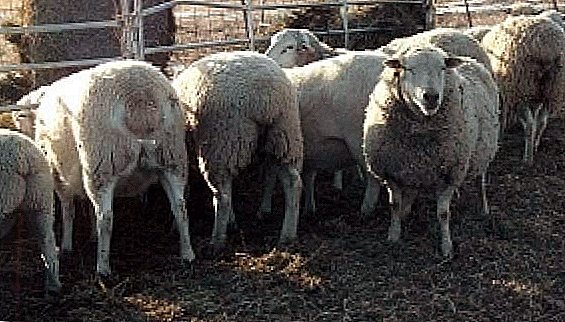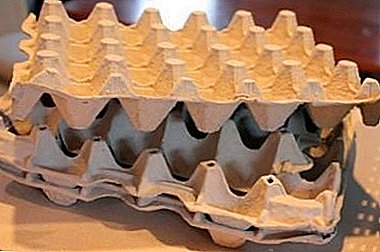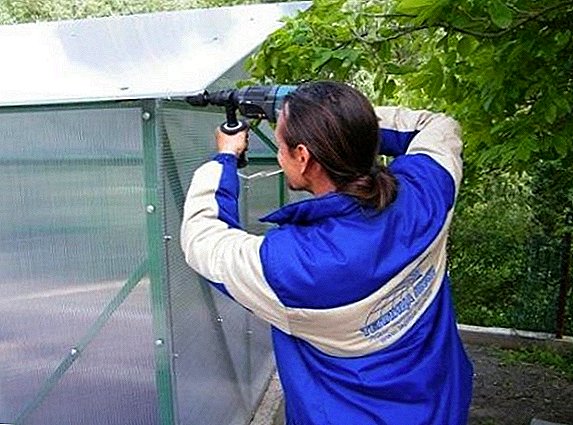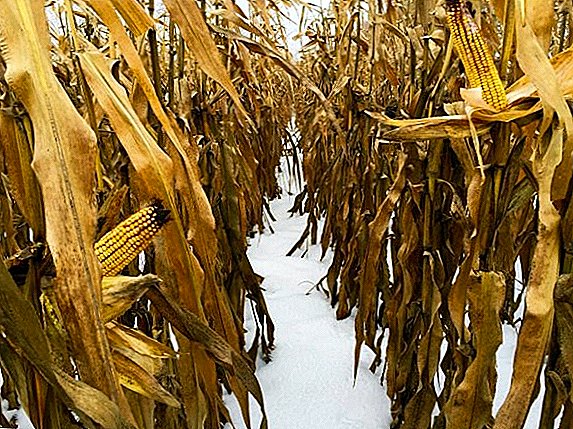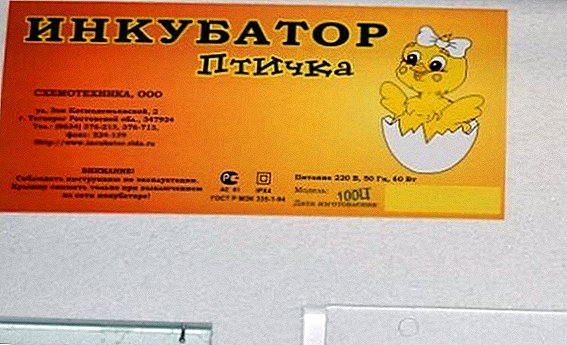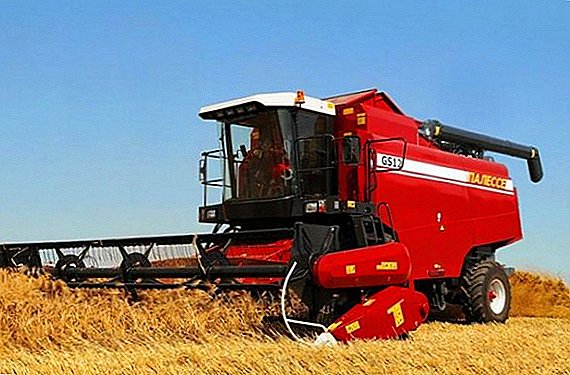 The fact that the Polesye combine harvesters produced by the Gomselmash enterprise in the Belarusian city of Gomel are being exported to many countries of the world and constitute a serious competition to foreign analogues is not very surprising. The speed with which Gomel designers, engineers and workers achieved such success is striking. After all, even in the late nineties, the company produced only forage harvesting equipment, harvesting agricultural products for silage. And only at the beginning of the two thousandth years there, for the first time, they began to produce much more complex harvesting machinery. And in such a historically insignificant period, the company's products have reached the international level of quality.
The fact that the Polesye combine harvesters produced by the Gomselmash enterprise in the Belarusian city of Gomel are being exported to many countries of the world and constitute a serious competition to foreign analogues is not very surprising. The speed with which Gomel designers, engineers and workers achieved such success is striking. After all, even in the late nineties, the company produced only forage harvesting equipment, harvesting agricultural products for silage. And only at the beginning of the two thousandth years there, for the first time, they began to produce much more complex harvesting machinery. And in such a historically insignificant period, the company's products have reached the international level of quality.
Device combine "Polesie"
Actually, the combine consists of two main parts: threshing unit mounted on a self-propelled wheeled chassis, and the reaper, which is a trailer mechanism for cutting the stems of grain crops.
We recommend that you read how to choose a mini-tractor for work on the backyard plot, about the features of mini-tractors: Uralets-220 and Belarus-132n, and also learn how to make a mini tractor from a motoblock and a mini-tractor with breaking frame.
Thresher consists of:
 1 - receiving chamber; 2 - single cabin; 3 - bunker drive; 4 - power installation; 5 - conveyor unloading in auger version; 9 - deflector device; 7 - straw walker knot; 8 - driven pneumatic wheels; 9 - grain cleaning and waste disposal unit; 10 - leading pneumatic tires; 11 - threshing unit; 12 - cockpit ladder
1 - receiving chamber; 2 - single cabin; 3 - bunker drive; 4 - power installation; 5 - conveyor unloading in auger version; 9 - deflector device; 7 - straw walker knot; 8 - driven pneumatic wheels; 9 - grain cleaning and waste disposal unit; 10 - leading pneumatic tires; 11 - threshing unit; 12 - cockpit ladder
- an inclined chamber that takes over the cut mass from the reaper and sends it to the threshing compartment;
- threshing mechanism for separating the grain from the stem mass;
- cleaning unit separating the separated grain, which is passed through the lattice system and remains at the same time clearing the litter with air flow;
- straw walkers, which finally separates the stem mass from the cleaning unit, after which completely clean grain is sent to the bunker compartment;
- storage bin equipped with sensors that monitor the filling level, sampling holes, and auger device for unloading grain;
- power plants in the form of an eight-cylinder diesel engine;
- electronic devices that control grain processing and control, as well as supervise the work of the combine using an onboard computer;
- transmission node and running control;
- a cabin that meets all the requirements of comfort and is equipped with heating, ventilation and a control panel.

The second component of the Polesye combine is the reaper, which is used as the grain header of the ZhZK.
Did you know? The world's first grain harvester was designed and built in the United States as early as 1836. He was on horseback or buffalo.
Technical characteristics of the combine "Polesia"
The model range of the Polesye combine harvesters is represented by aggregates having technical characteristics and specific functions designed to perform various agricultural tasks:
- Model of the combine, according to the export classification denoted as GS05, It is intended for small farms that require equipment that is inexpensive, small, economical, but at the same time quite productive. Meeting these requirements, GS05 successfully copes with threshing grain and grass seeds. The harvester qualitatively cuts, threshes, separates and cleans crops, accumulating grain in the bunker and then unloading it into vehicles. This model is capable of processing the non-grain sector of the crop, forming rolls from straw. GS05 is equipped with a 180-210 horsepower diesel engine, has a 4.5 cubic meter bunker, with a single-drum threshing system, a three-stage cleaning system and a four-button straw walker, it provides a capacity of 7.2 tons of grain per hour.
- GS10 Combine, in addition, he is able to perform all the functions of the previous model, more productive, and can cope with any level of grain yield. It is equipped with a 250 horsepower diesel engine, the combine uses a single-drum threshing system with a five-button straw walker, uses a three-stage cleaning system, has a bunker with a volume of 7 cubic meters and has a capacity of 15 tons of grain per hour.


Familiarize yourself with the tractors: Belarus MTZ 1221, DT-54, MT3-892, DT-20, MT3-1221, K-700 K-700, K-744 Kirovets and K-9000 K-9000, T-170, MT3 -80, MT3 320, MT3 82 and T-30, which can also be used for different types of work.
- The most demanded today combine harvester "Polesie" KZS 1218, according to the international classification GS12, it is able to work in any weather and in any climate, practically paying no attention to the complexity of the field, nor to the moisture of the grain. The unit is adapted to work with the largest variation in yield levels, per second can pass through itself at least 12 kilograms of canted mass and in one hour grind more than 18 tons of product. Such a high performance of the combine is reported by a 330 hp diesel engine, the presence of two threshing drums, an extended separation area together and improved cleaning. This model can also cope with the non-cereal component of the harvested massif, forming rolls from the stems or grinding them into silage.
- GS14 model represents the powerful combine intended for processing extensive agricultural areas with high productivity of all crops which are subject to the thresh. The model is equipped with a 400-horsepower diesel engine, uses a two-drum threshing system, six-button straw walker, and a three-stage purge system with a purge, has a 9 cubic meter bunker and develops a discharge capacity of 100 liters per hour.
- Polesie GS16 - even more powerful equipment designed to work in fields with the highest yields. The unit is able to handle all threshed crops in the most difficult working conditions. The GS16 has a diesel engine of 530 horsepower, uses a two-drum threshing system, two rotary straw walkers, has a 9 cubic meter bunker and has a discharge capacity of 100 liters per second.
- And finally, the GS812 model, belonging to the middle class and intended for harvesting a low or medium crop. It is able to work in conditions of poor terrain, has a comfortable cabin, equipped with air conditioning and on-board computer. The model has a diesel engine with a power of 210-230 horsepower, it uses a single-drum threshing system and a four-button straw walker, has a 5.5 cubic meter bunker and a capacity of 12 tons of grain per hour.




Did you know? The largest American grain harvester in the world is the American unit CR 10.90 from New Holland, which is listed in the Guinness Book of Records due to the fact that it managed to thresh 135 tons of wheat within an hour.
Design features
The designers of the Polesye combine, as well as the engineers and workers who produce it, managed to create a unit that is distinguished by long maintenance-free operation, resistance to high loads, ease of operation, ease of movement on any soil and, most importantly, stable purity of the threshing.

The positive qualities of the design of the combine should also be attributed to powerful motors, high levels of performance and energy saving, comfortable work place of the combine and rather quiet operation of the machine.
The most popular and affordable tools for today are cultivators and tillers. Through the use of attachments using the motoblock, you can dig and pile up potatoes, remove snow, dig the ground, and use as a mower.
Features harvester harvesters "Polesie"
Gomel-mounted headers with a width of 4 to 9.2 meters have high productivity, which is provided by the high frequency of cutting of the cutting apparatus, constituting 1108 strokes every minute. The cutting machine itself is equipped with reliable fingers that have cutting edges that provide a clean cut of the stems, and at the same time self-cleaning.

The pneumatic accumulators with which the cylinders of lowering and raising the inclined chamber are equipped eliminate the possibility of damage to the inclined chamber and the entire header by irregularities in the field.
Fixtures for rapeseed or corn are easily installed on the header. In the case of corn, these devices help to separate the cob from the stalks of the plant, as a result of which the cobs are threshed and the stems are finely cut for the subsequent preparation of silage.
 Hydropneumatic accumulator
Hydropneumatic accumulator
System threshing combines "Polesie"
This system is designed so that it provides threshing even wet and crowded weatherproof grain plants.. For this, a special acceleration drum increases the rate of movement of the cut mass, which the inclined chamber supplies, coordinating it with the number of revolutions of the threshing drum. And the accelerator drum, making the distribution of the moving mass uniform, effectively reduces the pressure on the threshing drum and the main concave.

Straw shooter and cleaning system
Belarusian machines use highly efficient modern grain cleaning, thanks to which the grain enters the bunker in high quality condition.

For this, for example, a five-key seven-decade straw walker provides the keys with the necessary height variation. The swing of the keyboard toward each other is created fairly high so that the grain stands out better from the straw mass.
Did you know? In Russia, rye, wheat and barley were pressed down with a sickle, mowing with a scythe was considered a sin.
The extensive area of the mill on which the sieves are located, as well as the three-stage cleaning and the turbofan, which evenly distributes the air flow through the sieves, allow for high-quality cleaning of the grain.
 Air flow rate change
Air flow rate change
Storage Grain Tank and Fuel Tank
The volume of the storage bins of the combine, depending on the model, are from 4.5 to 9 cubic meters. They correlate well with the volumes that grain carriers are capable of transporting. Level sensors and special windows for sampling grain are built into the bins.

Combines are equipped with plastic fuel tanks with a capacity of 600 liters, which allow the units sufficient time to work continuously, without wasting time on frequent refueling.
Cabin
In terms of their comfort, the cabins of Belarusian combines are not much lower than those of passenger cars. And in size they are clearly superior. Cabin glazing creates excellent visibility of the cultivated field, while the cabs themselves are reliably protected from vibrations and noise and are equipped with air conditioning.

All the nodes of the combines and the whole system are under the control of the on-board computer, which, in accordance with the modern requirements of ergonomics, is very convenient for the combine.

Optional equipment
Optionally on the Belarusian grain aggregates, you can install rapeseed cleaning equipment, which increase the header table and allow the rape to be squeezed strictly along the very edge of the spindle, minimizing grain losses with rapeseed reflectors.

A special set of corn equipment allows you to simultaneously extract grain from the cobs and chop the corn stalks for silage. Also combine with harvesters "Polesie" reapers, designed for harvesting soybeans and sunflower.
As an option, you can use a gearbox to reduce the speed of rotation of the drum.
Operation Combine "Polesie"
As already emphasized, the Belarusian equipment can be operated in all climatic conditions and in any weather. The machines are capable of harvesting and threshing wet and lying crops, moving on viscous soils, while ensuring high quality of grain.
Important! The efficiency of Belarusian harvesters meets modern international criteria.
Fuel consumption rate
The amount of fuel consumed for combine operation depends on the engine power installed on a particular model, as well as on the operating conditions of the unit. For example, the most demanded GS12 model consumes on average about 26 liters of diesel fuel per hectare of cultivated area. With a rated power of 330 horsepower, specific fuel consumption is 206 grams per kilowatt-hour.
 Tfuel tank
Tfuel tank
Application area
The way Belarusian harvesting machines behave in real working conditions can be clearly seen in the videos:
Video: Combine Polesie GS12 in the field
Video: combine harvester KZS-1218 "PALESSE GS12"
Benefits
In addition to high performance, efficiency, quality of threshed grain and maneuverability, Belarusian cars are also attracted by the pronounced economic expediency of their acquisition. Their foreign counterparts are not only significantly more expensive, but even more expensive to repair, maintain and purchase parts.

Meanwhile, Belarusian harvesters, being much cheaper by themselves, allow saving in the process of further operation, rarely failing, and, if necessary, costing inexpensive repairs.
As a result, this technique quickly pays off and makes it possible to get quick profits.
disadvantages
With all its distinct advantages Belarusian combines are not without some flaws.

Consumers are losing grain, which, when climbing or side slopes, increase markedly. The reason for this are the excessive length of the deck of the drum and accelerator. This is also due to the low elevation angle of the straw walkers. Difficulties arise when turning on the chopper, and there are also complaints about the reapers, which are often deformed.
Important! Causes complaints quickly fade in the sun, and often - and completely falling off the paint on the unit.
Reviews
Nevertheless, the majority of consumer feedback on Belarusian products is positive. Agricultural producers, writing, for example, on the official website of Gomselmash, most often note the high performance of Belarusian machines, their ability to work in difficult conditions, accurate service maintenance, reliability and trouble-free operation and comfortable conditions for the combineer.

Analogs
The most famous competitors of the Belarusian machines are units from well-known global manufacturers:
- american john deere with its models of the T and W series and the flagship of the John Deere S680i line;
- American Case IH, representing the model Case IH Axial-Flow 9230 and the flagship machine Case IH Axial-Flow 9230;
- American Challenger with its Challenger CH647C, Challenger CH654B and Challenger CH670B (660/680) combine harvesters;
- german claas and its models Lexion 770-750 and Tucano - 480/470 and 450/320;
- Canadian Massey Ferguson with MF ACTIVA S and MF Beta 7370;
- Italian Laverda, releasing models M 306 Spesial Power, Laverda REV 205 ECO, Laverda60 LXE and Laverda LCS 296;
- american new holland and its combines series New Holland CX 8000, consisting of seven models - from CX 8030 to CX 8090;
- Russian Rostselmash with its own units of models Acros 590 Plus and Torum 780, Niva Effect and Vector 410;
- Russian "Krasnoyarsk Combine Plant", Yenisei 1200 and Yenisei 950 producing machines.









Feedback from network users





